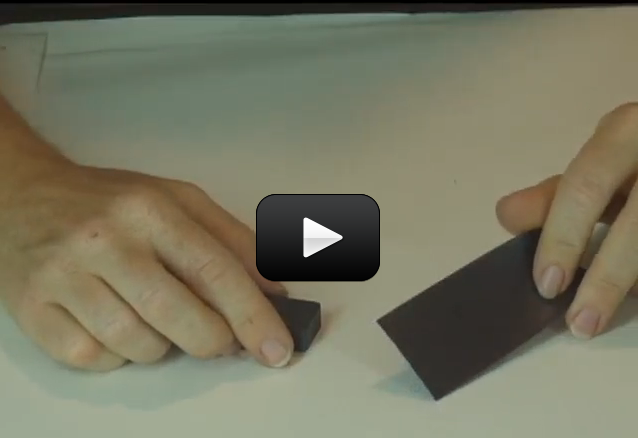Friction is everywhere! Imagine what the world would be like without friction! Everything you do, from catching baseballs to eating hamburgers, to putting on shoes, friction is a part of it. If you take a quick look at friction, it is quite a simple concept of two things rubbing together.
However, when you take a closer look at it, it’s really quite complex. What kind of surfaces are rubbing together? How much of the surfaces are touching? And what’s the deal with this stick and slip thing anyway? Friction is a concept that’s many scientists are spending a lot of time on. Understanding friction is very important in making engines and machines run more efficiently and safely.
Here’s what you need:
Please login or register to read the rest of this content.


Hi Aurora,
I accessed Download Student Worksheet and Exercises link in IE, but not Chrome or Firefox.
Thanks,
Dom.
I’ll have my programmer look into this issue to fix them for you. You shouldn’t be having this issue! So sorry about that. Are there any others you can’t access?
I have the link working here in IE and Firefox… what browser are you using? We want to be sure to fix this in case others have similar issues.
Hi Aurora,
I have just looked and all links to the remaining lessons in the Friction sub-topic seem to be broken. Would you please send these as well?
Thanks,
Dom.
Hi Aurora,
I cannot access the link again. Would you please send the direct link for this lesson?
Thanks,
Dom.
Interesting question! What happens when you rub two objects (like bricks or your hands, not just magnets) together? The friction warms up the surfaces! When you do this with magnets you are also creating magnetic waves when you have the magnetic fields interact with each other, but they don’t generate any heat that is detectable… so yes they warm up, and it’s due to friction.
Do the magnets get warm when you rub them together? I tried to tell but I didn’t know because my hands were warm.
Raena ?;]
When you put a piece of saran wrap on a window you get the chemical bonding reaction you speak of where they don’t want to stick and slip anymore but they bond together and won’t slide. Just make sure you don’t have any wrinkles in the saran wrap.!
Cool! It’s all about sharing! Thanks, Aurora.
Krishnaya
Short answer: because of plus and minus charges (electromagnetic forces).
Longer answer: We cover this idea in Unit 3 and Unit 8, but it’s got to do with electron sharing. Electrons provide the size and stability of the atom and, as such, the mass and the structure of all matter. Electrons are also the key to all electromagnetic energy. But wait, that’s not all! It is the number of electrons in an atom that determines if and how atoms come together to form molecules. Electrons determine how and what matter will be.
Atoms like to feel satisfied and they feel satisfied if they are “full”. An atom is full if it eats four hot dogs and a large fry. (Just kidding. ) An atom is “full” if its outer electron shell has as many electrons as it can hold or if there are eight or a multiple of eight (16, 24 etc.) electrons in the outer shell. This is called the octet rule and works most of the time, but is not perfect.
If an atom is not full, it is not satisfied. An unsatisfied atom needs to do something with its electrons to be happy. Luckily atoms are very friendly and love to share. Most atoms are not satisfied as individuals. The oxygen atom has six electrons in its outer shell. It needs eight electrons to be satisfied.
Luckily, two Hydrogen atoms happen by. Each one of them has only one electron in its outer shell and needs one more to be satisfied. If both Hydrogens share their one electron with the Oxygen, the oxygen has eight electrons and is satisfied. Also, if the Oxygen shares an electron with each Hydrogen, then both Hydrogens are satisfied as well. Just like your mother told you, it’s nice to share. It is this sharing of electrons that makes atoms come together to form molecules. You can read more about it here.
Why do the chemicals bond?
Thanks,
Krishnaya Coleman Salgado
Hi Logan! You’re right – the magnets are going to act differently depending on how you line them up. Think of it this way – the two magnets you are using have a N and S pole, right? Where are the poles the strongest (most concentrated)? If you’re using one of those flimsy magnets (the thin kind that bend and are the shape of a business card), then those are actually made up of lots of smaller, weaker magnets, each with its own N and S poles. When you line them up all the same way, they add up to one larger pole. Does that help?
Here-s a piece of trivia for you – did you know that the Earth actually has 8 poles? It’s just that we use the two strongest ones as the North and South. 🙂
When I turned one of the magnets sideways(perpendicular), then the two magnets slid smoothly even though they were pressed together. When I turned it back so it was matched up exactly with the other magnet it would stick and slip again. Why is that? Thanks, Logan Pedersen